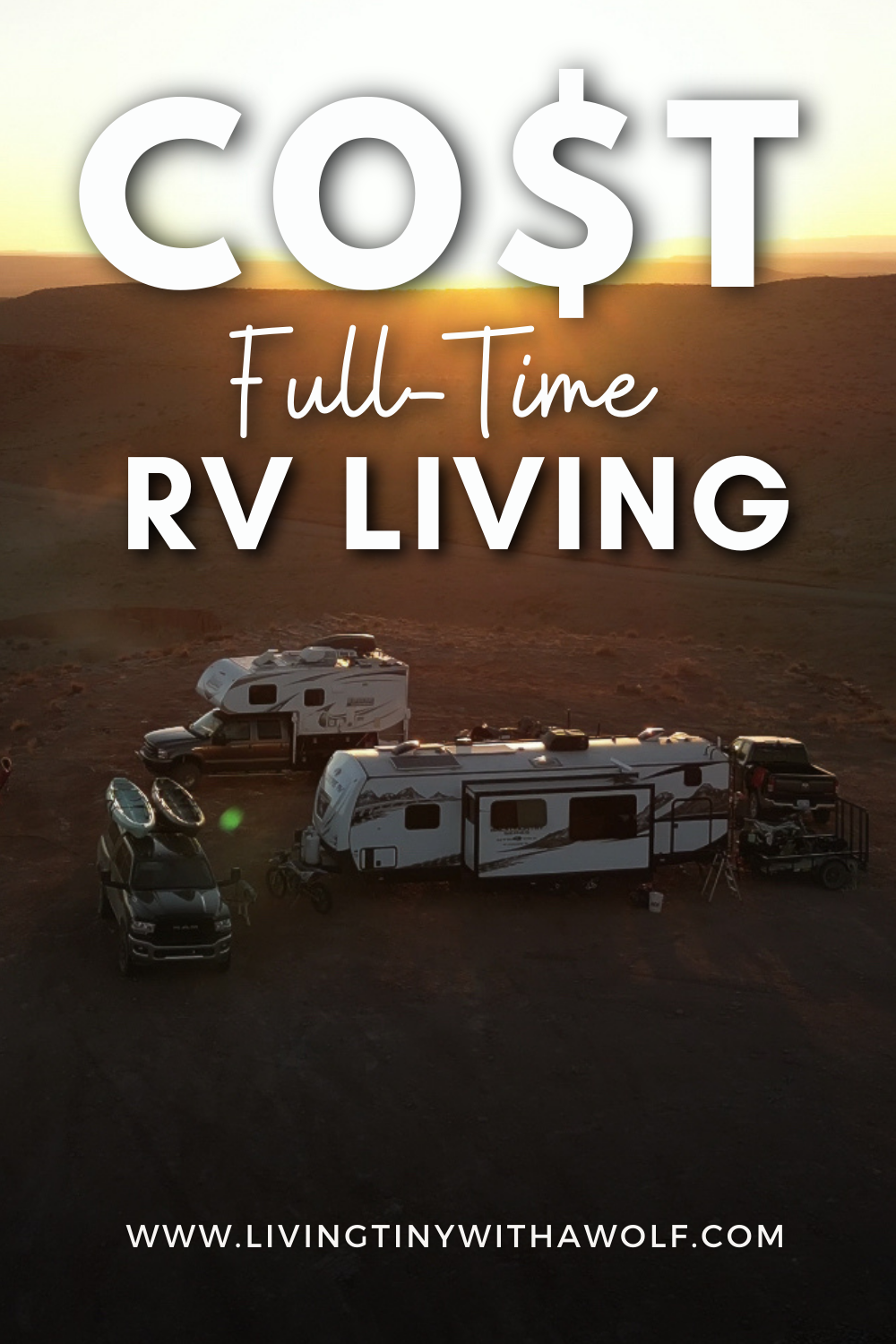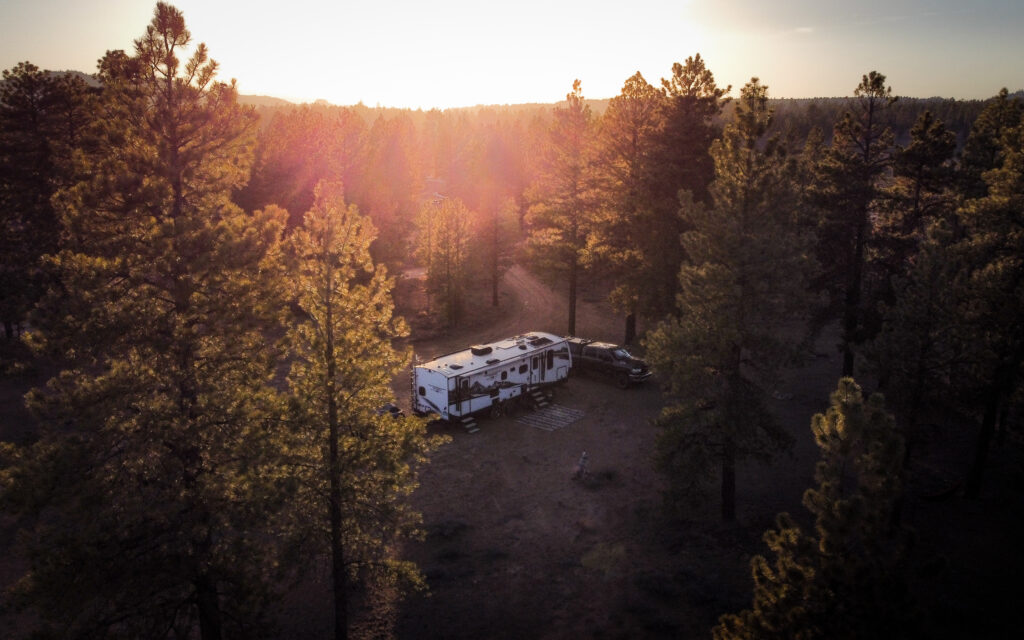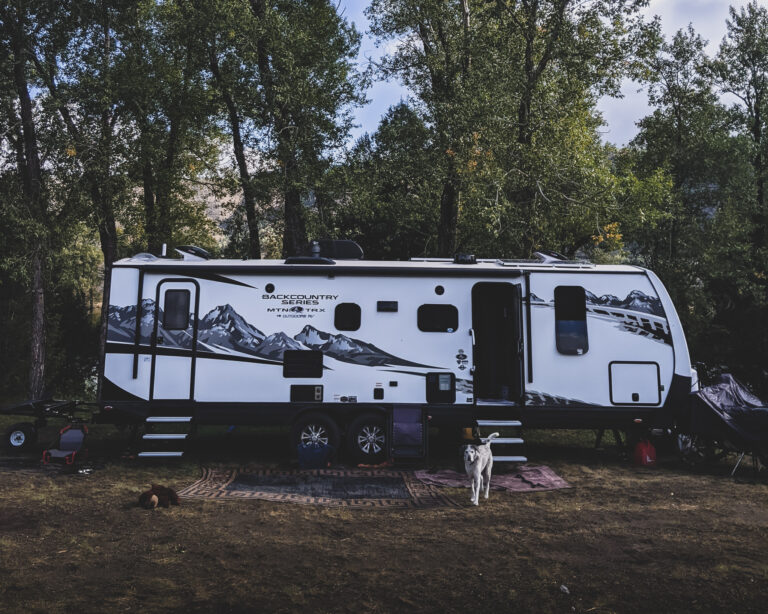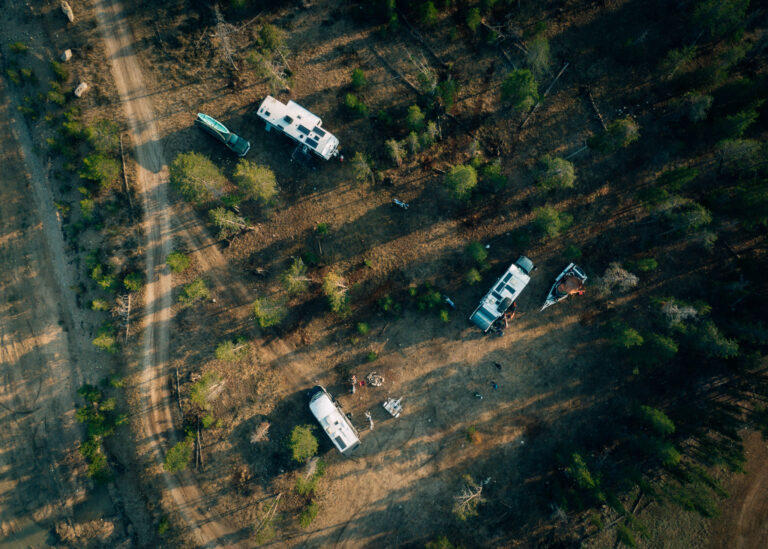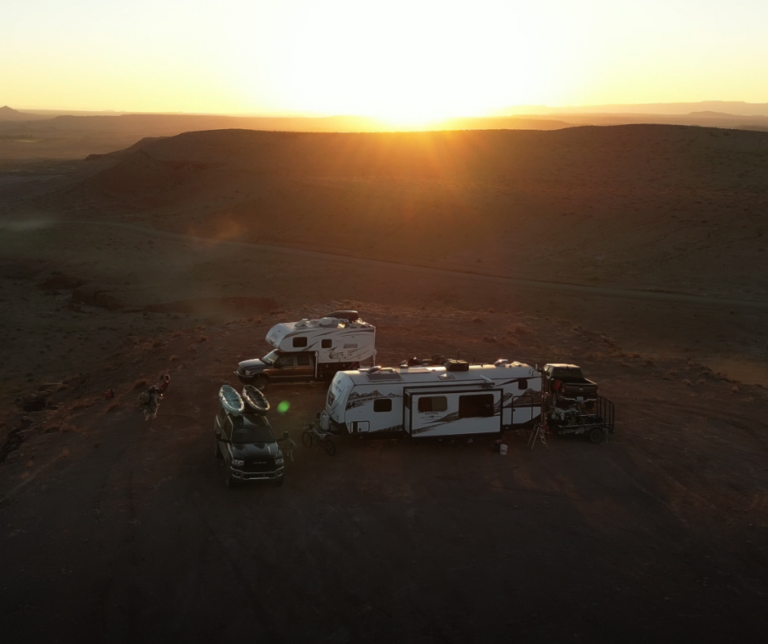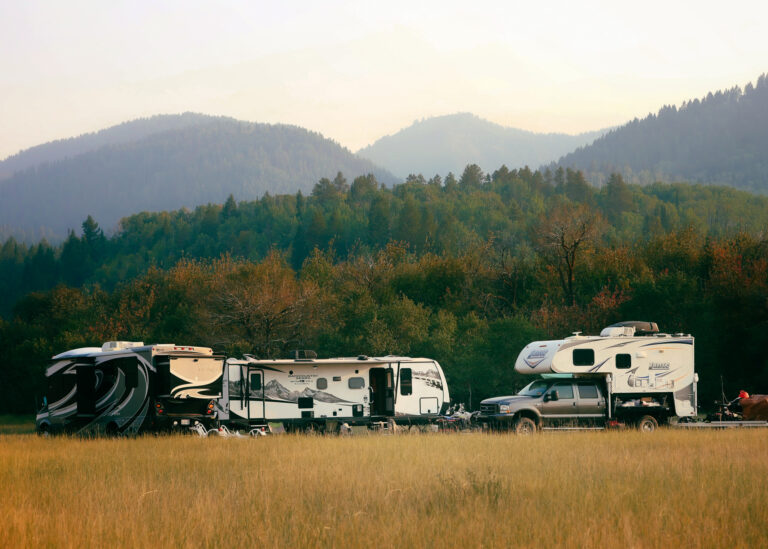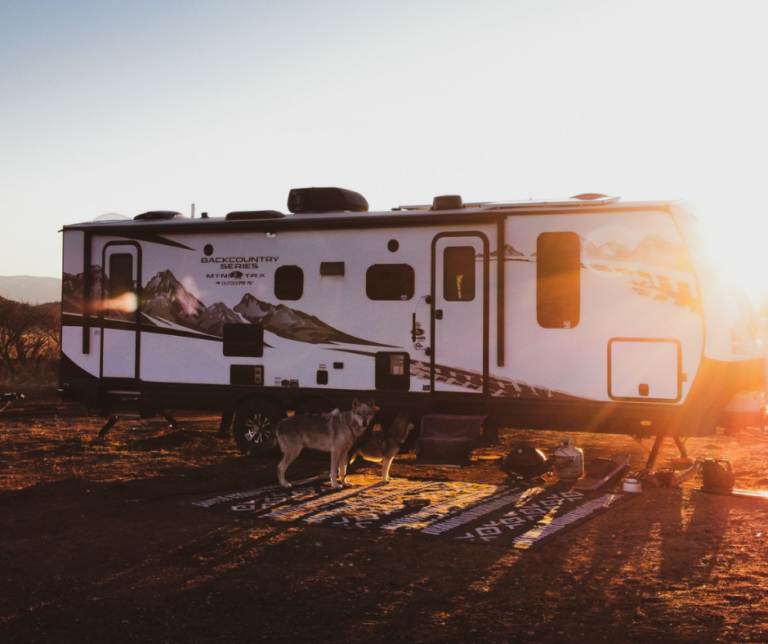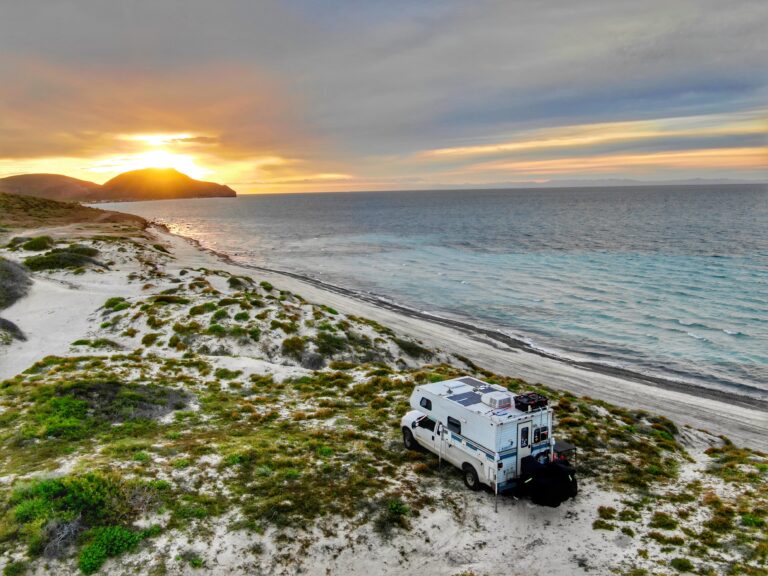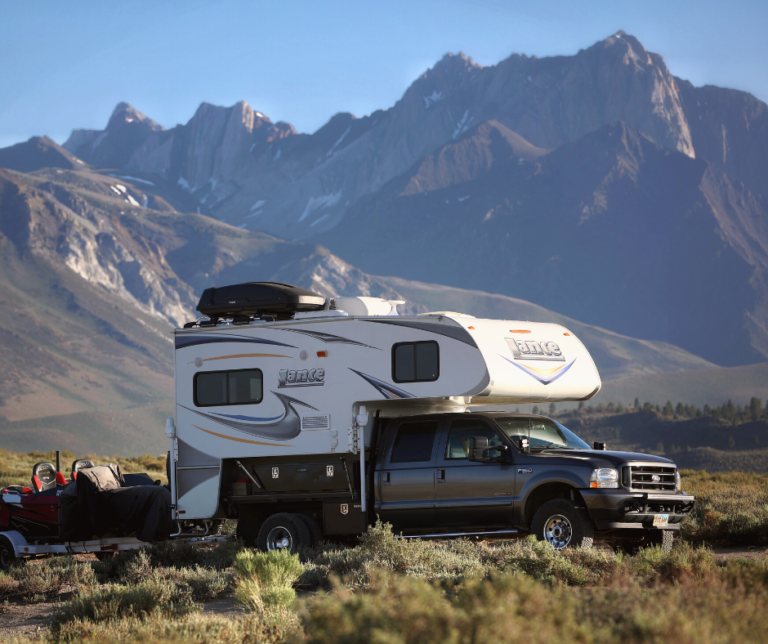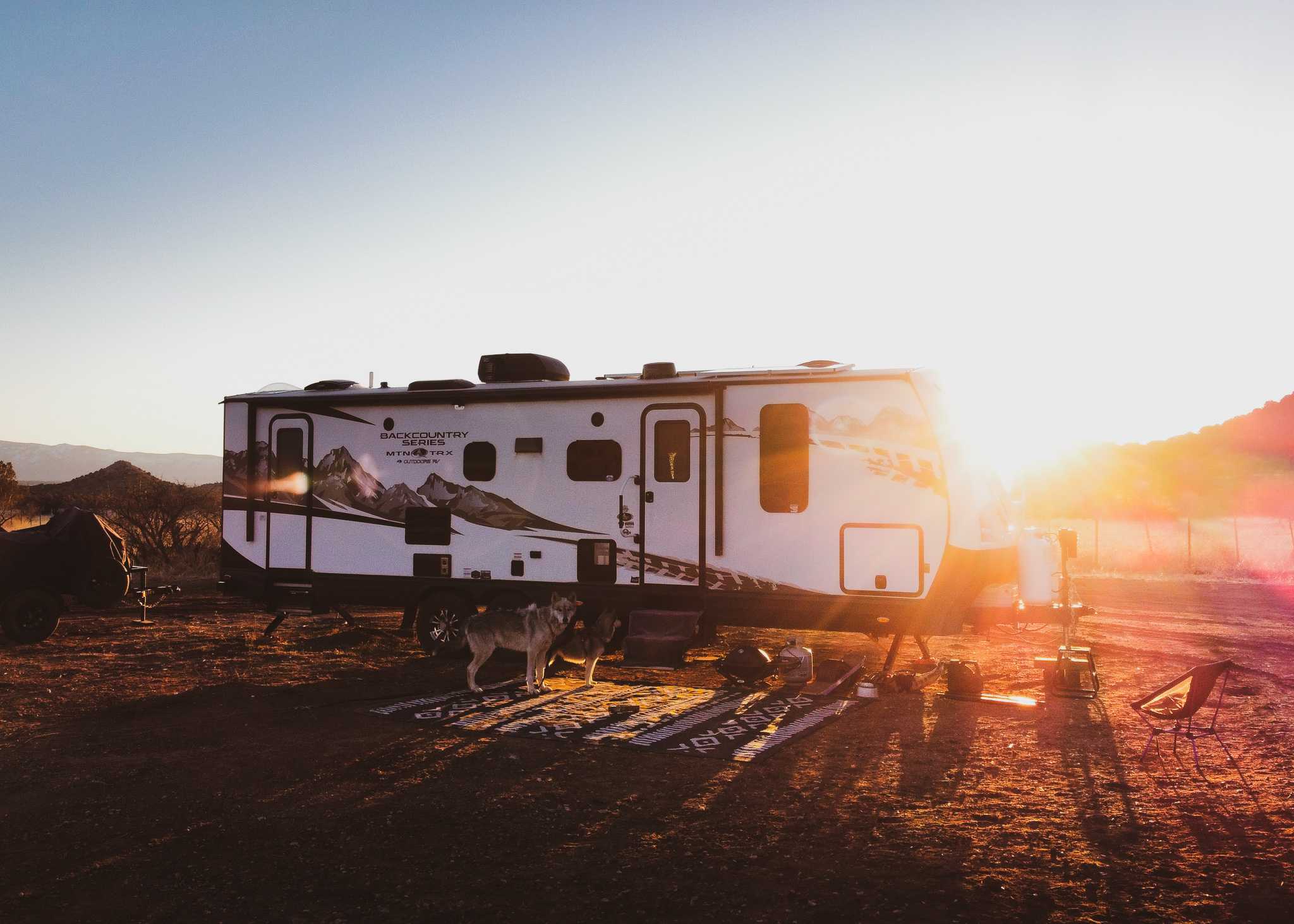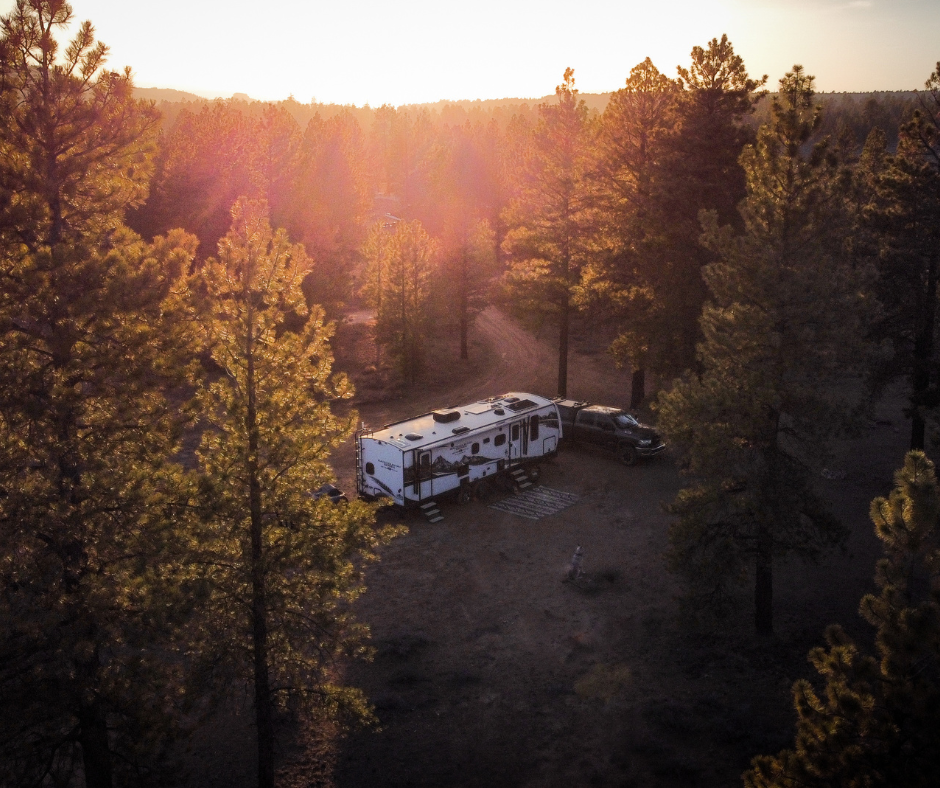How Much it Costs to Live in an RV Full-Time in 2023
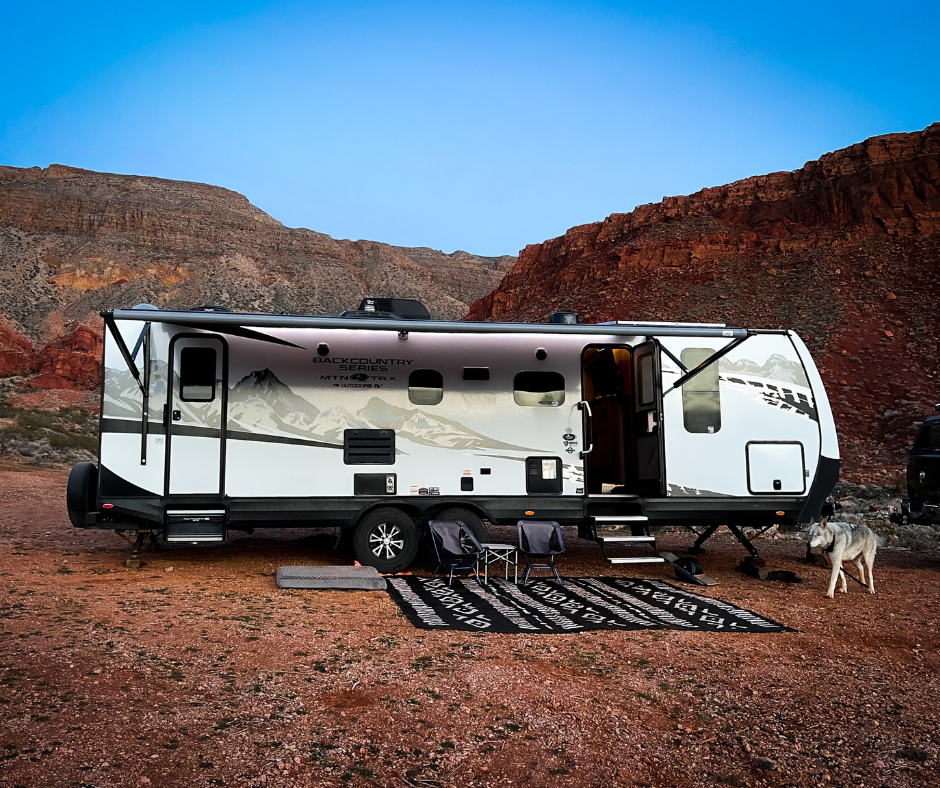
Are you tired of the same old daily grind? Bored with your predictable routine? Do you ever find yourself daydreaming about ditching the traditional 9-to-5 grind and hitting the road in an RV? We can’t blame you! Full-time RV living is a dream come true for many.
But one of the most common questions people have about RV living is: how much does it cost? Living in an RV full-time definitely has its costs, but it can be cheaper than you might think.
For us, living in an RV full time since 2019 has been an eye-opening and exciting journey. We’ve experienced life on the open road and seen some amazing places all while living below our means. Over time, we have figured out how to manage our expenses and save for travel funds.
In this blog post, we’re giving you a breakdown of the costs you can expect, as well as some tips on how to save money while RVing.
Table of Contents
ToggleFull-Time RV Living Monthly Costs
The cost of living in an RV full-time will depend on several factors, like the type and size of RV you choose, whether you plan to boondock or camp in developed campgrounds, and your location. That said, there are some basic costs that are associated with RV living no matter what your specific circumstances are.
I’ve taken our own budgeting process and divided it into two categories; monthly variable costs and monthly fixed costs. These include expenses like fuel and food for the variable side, as well as phone bills, insurance and vehicle payments for the fixed side.
Having a comprehensive view of all these expenses can help those considering taking their lives on the road in an RV full-time make informed decisions about their budget. By assessing both types of expenses before you set out, you’re ensuring that your travels are as comfortable, safe, and cost-effective as possible.
Hopefully, this breakdown of our costs of full-time RV living helps you out if you are considering this lifestyle too.
Full-Time RV Living Monthly Fixed Costs
The first step is understanding your monthly fixed costs associated with living in an RV full-time. These include things like your RV payments (if applicable) and truck payment (if applicable), health insurance premiums, vehicle insurance premiums, phone bill payments, and payments for any internet services such as Starlink.
While these expenses won’t change from month to month unless there is a rate increase from one of the providers listed above, it’s still important to budget for them each month so that they don’t sneak up on you.
Our Monthly Fixed Costs
Travel Trailer Payment: $404
Truck Payment: $704
Vehicle Insurance: $230
Travel Trailer Insurance: $170
Phone Bill: $135
Starlink: $135
Travel Trailer Payment
The biggest expense associated with living in an RV is usually the cost of the travel trailer itself. Depending on what type of RV you buy, your monthly payment could range from zero dollars, to a few hundred dollars, to several thousand dollars.
The monthly payments on our Outdoors RV Travel Trailer are $404, which when compared to rent or mortgage payments was a much more budget-friendly option for us. After researching further into how other RVers were taking on the lifestyle, we noticed that some had elected to purchase a used RV instead, which left them with no monthly cost whatsoever.
Truck Payment
If your RV isn’t self-contained, then you’ll also need to buy a truck that can tow it. Purchasing a new tow vehicle for our full-time RV travels was a tough but necessary decision. We wanted to make sure we had reliable transportation wherever we went, so the added monthly expense of paying for a truck was worth it and we pay $704 a month for a 2020 Ram Powerwagon.
However, some travelers make the decision to buy their tow vehicle in full, completely omitting any monthly payments. This can be harder at first since the cost is coming out of your savings account rather than spreading out those costs over time, but it has its advantages down the line if you want to save money and become debt free quicker.
Although our route might be a bit harder with an added payment every month for our truck, I am happy with our decision.
Vehicle Insurance
You’ll also need to factor in vehicle insurance costs for both your truck and your RV (if applicable). Again, these costs will vary depending on where you live, and other factors but they’re essential for protecting yourself financially if anything happens while traveling.
We pay $230 a month for our truck insurance through Progressive and it’s absolutely necessary as we travel from state to state. It gives us peace of mind that if something ever were to happen, we would be covered. Sure, it may not be one of the most thrilling expenses associated with RV travel, but having a reliable truck to get around in is key and insurance helps to ensure that we are always taken care of.
Travel Trailer Insurance
When it comes to finding the ideal travel trailer insurance policy, it is essential to shop around and consider all options. Rates can vary widely from company to company and policy to policy. To make sure you get the best deal, take some time to evaluate quotes from multiple companies—compare both coverage and cost. Be sure that the policy you choose will provide coverage for your trailer when it is being lived in full-time, as well as any of your contents that may be inside.
We pay $170 per month for our policy through Foremost, and having insurance on our travel trailer gives us peace of mind. As travelers, life on the road can be unpredictable so having that extra layer of insurance to back us up makes all the difference.
Phone Bill
Depending on how often you plan on using data while traveling, you might consider getting a phone plan that includes unlimited data so that you don’t have any unexpected bills at the end of each month. This can help ensure that there are no surprises when it comes time to pay bills each month. Additionally, some phone plans offer discounts for multiple lines which may be useful if there are multiple people living in the same household who need access to data while traveling full time.
We pay only $135 a month for two users with Verizon. Not only does Verizon have some of the best coverage in the US, but their plans let us stay connected without breaking the bank.
Starlink
If internet access is important for work or other activities while out on the road, then consider investing in Starlink satellite broadband service which offers high-speed internet connection from anywhere in North America (or beyond).
Although Starlink does cost us $135 a month, it is beyond worth it. We depend on the internet to work, so having access to a reliable connection is essential. On top of that, the speed and coverage we enjoy while traveling has far surpassed any other service we’ve used before.
Full-Time RV Living Monthly Variable Costs
In addition to fixed expenses, there are also variable costs associated with living in an RV full-time. These will include things like groceries, pet supplies, fuel for your vehicle and your RV, tolls for when you drive on highways or bridges, propane for heating and cooking, campground fees (which vary depending on where you are), restaurants (if you don’t want to cook every day), entertainment (movies or shows), and any necessary repairs or maintenance for your RV or truck.
It’s important to note that while these items are all considered “variable” because they may change each month depending on where you stay and what activities you do, they should still be budgeted for each month so that you don’t end up overspending.
Our Monthly Variable Costs
Groceries $800
Fuel: $300
Propane: $120
Pets (food, vet, toys, etc): $170
Campground Fees: (varys depending on location): $0-$700
Restaurants/Entertainment: $150
RV & Vehicle Repairs/Maintenance: $200
Laundry: $50
Tolls: $0-$100
Black Tank: $0-$40
Groceries
One of our most significant expenses while living full-time in an RV is food, which can easily run $1,000 a month or more. I like to think of myself as quite the chef (lol), creating delicious and nutritious meals while living on the road.
Plus, we like to eat a lot, so having fresh ingredients is important to us; I try to focus our budget on healthy options such as fresh produce while avoiding excessive spending on snacks and pre-made meals.
Here are some tips on how to be prepared while on the road:
Take Advantage of Membership Rewards
Not everyone is aware of this, but many supermarkets belong to the same chain, allowing customers to reap the rewards of memberships regardless of their location or store. For example, when you register your phone number with Kroger, you are eligible not only at Kroger locations, but also at Smith’s Food and Drug, Lyns, City Market–and more!
Stock Up Before You Go
One of the best ways to save money on groceries while full-time RV living is to stock up before you leave. If you know that you are going to be visiting remote places like National Parks or remote towns, it’s essential that you go into them stocked up with all the essentials so that you don’t have to pay inflated prices at convenience stores or other small mom-and-pop shops.
Non-Perishables And Frozen Meals
Another great way to ensure that you are always well-stocked is to purchase non-perishable items like bags of rice and frozen meat in bulk from discount retailers like Costco or Sams Club. We love buying chicken, ground beef and burger patties in bulk and dividing the servings we need for a meal into freezer bags. I find that these types of stores often offer great deals on bulk items which can save you a lot of money.
Have Emergency Food Storage
Emergencies, such as natural disasters, road closures, or vehicle breakdowns, can occur at any time, leaving you and your family without access to food. We like having an emergency food storage bucket to ensure we have access to sustenance in these situations.
Fuel
Full-time RV living can be a great way to explore the country, but it does require some planning and budgeting. One of the more important considerations is the cost of fuel for your RV. Depending on how far you plan to travel and what type of rig you have, that cost can vary greatly.
Additionally, Gas prices vary significantly from state to state and can even fluctuate due to global economic conditions or political situations. To save as much money as possible, we use the GasBuddy app to check gas prices both where we are currently located and where we are going next. This helps us stay informed about changing prices so that we can avoid paying more than necessary for our travels.
Calculating Your Distance Traveled
How far you travel will have an impact on the amount of fuel you use. If you plan to move around a lot, then this could be quite costly. This means that if you plan to take a long road trip across several states, you should expect an increase in fuel costs compared to staying in one spot for several months at a time. We recommend planning out each month in advance so that you know when and where you’ll be traveling next.
Understanding Fuel Economy
The term “fuel economy” refers to how much fuel your vehicle needs to cover a certain distance—in other words, its efficiency rating. Knowing the average gas mileage of your rig can help give insight into how much money it takes for each mile traveled. This calculation can be done by taking into account both city and highway miles per gallon (mpg). Generally speaking, smaller rigs tend to have better mpg ratings than larger ones due to their size and weight difference.
Using Your Generator Responsibly
In the winter, we often find that there is not enough sunlight available to power up our RV. This is where our generator comes in handy as it is able to provide energy through a combustion engine, powered by gasoline fuel. However, running them too often can quickly add up in terms of money spent on gasoline and maintenance fees over time so it should be used responsibly whenever possible. Consider investing in solar panels or other renewable energy sources so that less generator usage is required throughout the year.
Propane
One of our biggest costs associated with RV living is propane. From powering the refrigerator to running the heater, propane is a necessary expense that can add up quickly if not managed properly. We usually fill up our two 10 gallon propane tanks once a month in the summer and every two weeks in the winter. We use significantly more propane in the winter.
Expect Propane Cost To Fluctuate
The average price of a gallon of propane varies between $3 and $4 per gallon around the United States, however, keep in mind that prices may fluctuate depending on local market conditions.
Calculate Propane Usage
The amount of propane you’ll use will vary depending on several factors such as your climate, how often you’re using appliances that require propane (such as the heater or grill), and how well-insulated your RV is. Generally speaking, however, most full-time RVers find that they need about 20-40 gallons of propane per month in order to comfortably live off the grid.
Pets
One of the biggest expenses for us as pet owners is dog food. We have 2 big dogs (Gunner & Bella) and a wolfdog (Cruze), so feeding them all can get quite expensive. Plus, having a wolf dog means that he requires a diet that consists of raw meat, bones and organs in order to stay healthy. And while this diet is NOT cheap—however, its worth every penny if it means giving him the nutrition he needs.
Unexpected Vet Bills & Supplies
Another major expense when traveling with pets is vet bills and supplies like flea/tick prevention and heartworm medicine. Unexpected vet bills can come up anywhere along your journey, so it’s important to budget ahead of time for these expenses.
Our experience with our four-legged travel companions has been eventful, to say the least. Our sweet old dog, Gunner contracted Valley Fever while wandering through Arizona’s deserts and needed an antifungal treatment in order to recover. Remarkably, despite his illness, he bounced back stronger than ever and continues to accompany us on all of our adventures. Cruze, on the other hand, got sick and was throwing up and had blood in his stool. Thankfully we were able to bring him in for a vet visit and they nursed him back to health without any permanent physical damage. Both of these instances are why we like to have Prescription Antibiotics for Emergencies in our RV.
Toys & Treats
Just like humans need a little fun now and then, so do our furry friends!
Toys are an important part of keeping your pet entertained while living on the road—not only do they help prevent boredom (and therefore destructive behaviors), but they also provide stimulation that helps keep your pet healthy both mentally and physically.
We try to stick with durable toys that will last as long as possible since we don’t always have easy access to replacements on the road.
As far as treats go—well, let’s just say our pups get plenty of those too.
RV Parks/Campsite Fees
For some, campsite fees are one of the primary expenses associated with living in an RV full-time. Depending on what part of the country you are in, campsite fees can range from free (boondocking) to hundreds of dollars per night. While we almost exclusively boondock, we have stayed at RV parks here and there and know that those costs add up. Here’s what to consider at each type of camping location:
RV Parks
When staying in an RV park, campsite fees can range from $20-$80 per night depending on location and amenities. These parks typically offer water and electric hookups with some even offering sewer connections as well.
Many RV parks also offer free Wi-Fi access which can be a huge plus if you need to stay connected while on the road.
Since many of these parks are located close to attractions and activities, they tend to be more expensive than other types of camping locations. If you prefer to stay in a campground while full time traveling, you can save money by using a membership program:
- Boondockers Welcome: Boondockers Welcome is a membership program that connects RV travelers with hosts who are willing to let them stay on their property for free or at a discounted rate. Hosts can be found all over the country and in Canada, making it easy to find a place to stay no matter where your travels take you.
- Thousand Trails: Thousand Trails is another great way to save money on camping fees if you prefer staying in established campgrounds. With this membership program, you receive discounts at participating campgrounds all over the United States and Canada.
- Good Sam: This membership gives you access to discounts on camping fees as well as special deals on parts and accessories for your RV. Members also enjoy exclusive events such as camping rallies and educational seminars throughout the year.
- Harvest Hosts: If you’re looking for something a little different than traditional campgrounds, then Harvest Hosts may be right up your alley! This membership program allows RV owners to stay overnight at farms, wineries, museums, golf courses—you name it! Not only do members get access to these unique places but they also receive discounts on camping fees at select locations across North America.
National/State Park Campgrounds
Staying at a national or state park campground is often cheaper than staying in an RV park due to their more remote locations and fewer amenities. Campsite fees range from $10 – $30 per night with some parks offering discounts for seniors or those who have purchased annual passes. While these campgrounds usually do not have electrical hookups, many offer water spigots throughout the grounds that allow you to fill up your tank without having to leave the park.
Boondocking
If you are looking for an even cheaper option than camping at a traditional campground or RV park, boondocking may be right for you! Boondocking refers to camping on public lands (such as BLM land and in National Forests) where there are no facilities whatsoever including no electricity or water hookups. But, it’s completely free!
Read More: How to Find RV Campsites For FREE
Restaurants + Entertainment
The amount RVers should budget for entertainment will vary depending on their personal preferences and travel style. Some factors that may impact entertainment expenses include the type of activities you enjoy, the locations you visit, and the cost of admission to events or attractions.
As a rough estimate, RVers may budget anywhere from $100 to $500 or more per month for entertainment, but the actual amount will depend on your specific circumstances.
We enjoy dining out approximately once or twice a month, and occasionally treating ourselves to a movie, ice cream, or a visit to a National or State Park. We highly recommend investing in a National Parks Pass ($80 per year), as it pays for itself if you plan to visit more than one National Park in a year, saving you on entry fees in the long run.
It’s a good idea to make a list of the types of entertainment you are interested in and research the costs in advance to help you budget accurately. Keep in mind that there are many free or low-cost entertainment options available, such as hiking, exploring local parks, and attending community events, so you don’t necessarily have to spend a lot of money to have fun.
RV & Vehicle Repairs/Maintenance
It is important to factor in the cost of maintenance and repairs when budgeting for full-time RV living since these costs can add up over time due to wear and tear from constant travel.
In our case, we spend $100 every 20,000 miles on oil changes. And we have been traveling the last four years without any major issues. And since our truck is new, our warranty covers anything else that comes up along the way. Which has currently only been a wench repair.
However, I have seen friends fall victim to truck breakdowns of all kinds. But it taught me an important lesson: no matter how many preventative measures you take, having some money set aside for such occasions is essential. Friends of ours were stranded in Florida when their engine completely gave out and they had to pay thousands in repairs until they could get back on the road. So, I recommend setting aside at least $5,000 dollars to cover any unexpected repairs.
Laundry
When we decided to live full-time in our RV, one of the things we had to learn how to manage was doing laundry. After all, it’s something that can’t be avoided no matter where you live. But when you’re living in a tiny space and constantly on the move, there are some unique considerations to keep in mind when it comes to laundry.
How much it will cost you to do your laundry while living in an RV depends on a few factors. The most obvious is how often you do it. Most full-time RVers tend to do their laundry once a week (like us), which can range from $3.50-$5.50 per load depending on where you are in the country. That adds up to around $40-$80 a month not including the cost of purchasing detergent and dryer sheets. If you have kids or pets (or both!), your monthly costs could be even higher due to needing more loads each week.
Dumping Black Tank
Dumping your RV black tank usually isn’t expensive, but if you know some of our tips it can really save you money.
We’ve found that many Maverick Gas Stations have free RV dumping so that is a great go-to place for us to pull up and empty out our tanks. However, depending on our location, we may find ourselves paying closer to $15 each time we need to get rid of what’s filling our RV’s black tank.
Luckily, we can boondock for 2 weeks before needing to dump our black tank (40 gallons!) So keep that in mind if you have a smaller black tank and need to dump more often, the cost of doing so may be higher for you.
Tolls
One cost that can easily be overlooked is tolls. Whether you’re crossing state lines or just passing through a city, tolls add up quickly and can put a dent in your wallet if you don’t plan ahead.
We learned the hard way that when passing through most tolls, they charge per axel. Considering we have 5 axles —two on the truck, two on the RV, and one on our dirtbike trailer—it can add up quickly. On our last trip, every time we passed through a toll booth it cost us about $20.
The best way to save money on tolls is to plan ahead as much as possible. Having an idea of where you’ll be going and when will help you budget accordingly so that you can set aside funds for any potential toll roads you may need to take along your journey.
Our Tips for Reducing Cost of Living in an RV Full Time
- Saving up before you start traveling can make the entire experience much smoother, smarter and safer.
- Plan out a budget that incorporates all related costs and review your spending regularly.
- Don’t go overboard on spending when nature is all around us or free!
- If you’re staying at RV parks, they usually have daily/weekly/monthly rates, and monthly is always the most affordable.
- You can expect stuff to break on your rig every once in a while, so reserve part of your budget for repairs.
- Boondock! Seriously, not paying for RV parks frees up literally hundreds of dollars.
- Traveling slow saves a lot in terms of gas and other wear and tear on our rigs. We try to stick to the rule of spending at least a full two weeks in one spot before moving on.
Cost of Living In an RV Full Time Final Thoughts
For anyone considering full-time RV living, the wide range of budgets can be a bit overwhelming.
While of course every traveler’s lifestyle is unique and every budget reflects that, it is comforting to know that you’re able to live this lifestyle without going into debt.
With plenty of creative ways to save on regular expenses like groceries and gas, combined with an intent focus on living below your means, it really is possible to make monthly full time RV living work within any budget.
I have personally seen amazing examples of people who have made it work, with some spending as low as $1,000 per month and others more generously setting aside up to $5,000 per month.
It all comes down to what works best for your lifestyle and financial situation. With proper research and preparation, you will find that full-time RV living could be an incredible experience for you and your family at any budget level!
We hope this has helped you understand the costs of living on the road full-time in an RV. If you have anything to add or a personal experience to share about bugeting, please leave a comment below!

Love it? Pin it!
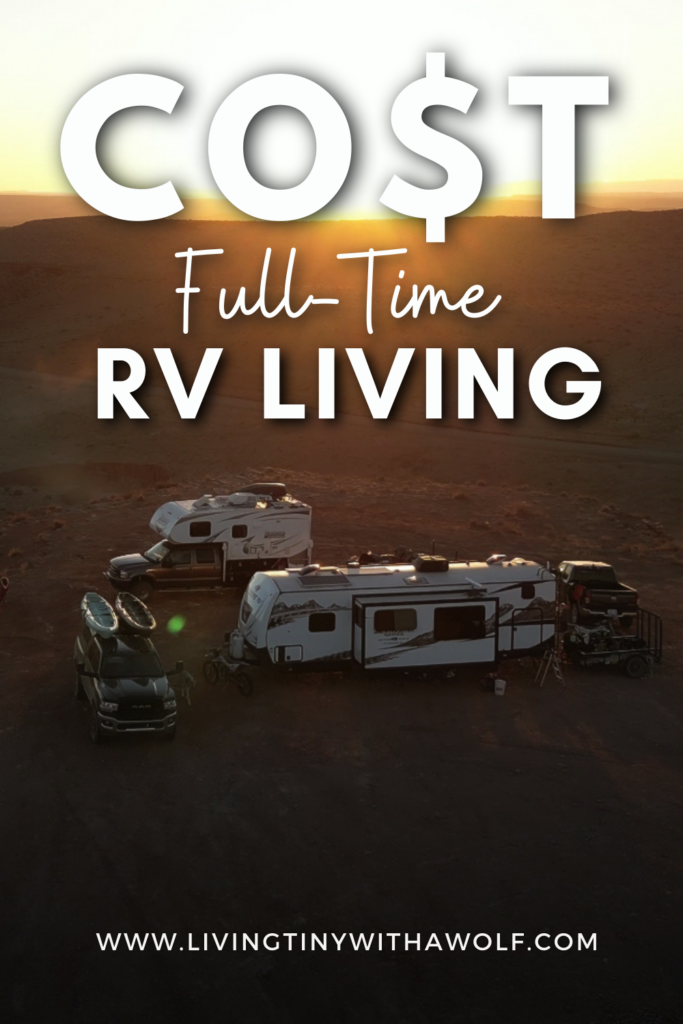
More RV Resources
